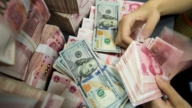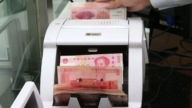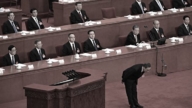【新唐人2012年4月4日讯】4月2号,大陆官媒转载地方媒体的报导说,3月官方制造业采购经理指数(PMI)连续第四个月回升, 而民间的汇丰PMI数值却连续四个月下滑,因此,不宜对官方PMI数据过分乐观,中国经济增长速度实际上正在走下滑路。专家指出,中国官方造假已经司空见惯,但是通过官方媒体曝光,说明目前的政治地震,给中国经济数据的透明程度,带来了一点缝隙。
2号《新华网》转载《广州日报》的报导,标题是:“官方民间PMI数据再现分歧,连续四个月背道而驰”。
《广州日报》的这篇报导说,“中国物流与采购联合会”和国家统计局“服务业调查中心”发布的3月份“中国制造业采购经理指数”(PMI)为53.1%,比2月上升2.1个百分点,连续四个月回升。但昨天公布的汇丰3月份中国制造业采购经理人指数,为48.3%,仍低于2月份的49.6%,实际上民间PMI已是连续四个月下降。
美国“南卡罗莱纳州大学”教授谢田认为,中共这次的政治大地震,开始打破中共对新闻和数据的垄断。
谢田:“中宣部看来是控制无力了。这实际上是民间的专业团体和地方性的报纸一步步在揭穿中共在经济上的谎言,中共为什么要用这种过分乐观和虚假的数字公布于众呢,他是要显示出来中国的经济有多么多么的辉煌,实际我们也都知道中国的经济在走下坡路。”
据《广州日报》这篇报导分析,民间与官方PMI走势相反的原因之一是,汇丰调查的样本主要是中小企业,而官方的调查则是选取大型企业。这样就导致调查结果完全相反,同时也说明了中国大型企业和中小企业“冰火两重天”的生存现状。
中国金融智库研究员巩胜利表示,中国官方数据的统计和世界其他国家采取的是不同的标准,再加上中国的经济数据是地方官员升迁的依据,含有大量的水分, 所以用官方数据来衡量中国的经济是没有意义的。
巩胜利:“你比如说,中国的消费指数和失业人数,它都是中国的特色,它有很多都不包括在内,中国的失业人数,你像美国它是所有的人都包括,中国它只包括城镇居民,不包括农民,你想中国80%的农村人口都不包括在内,它这失业人数还有什么可使用的价值。”
“浙江大学”商学研究院院长李志文告诉《新唐人》,因为中国是属于官本位,经济的数据往往根据上面的需要而作假,而国外的统计没有作假的需要。
李志文:“中国数据跟外国数据永远不一样,因为统计口不一样,统计口不一样呢,它收到资料不一样,还有它那个度量方法不一样,只有到有一天,就像美国一样的完全打开了,它才有一个统一统计口径。统计口径不一样其实对国家是相当不好的,就给下面的官员贪污的机会。”
统计数据显示,中国的PMI指数已经连续5个月低于50荣枯线以下。据了解,50通常被业界认为是PMI指数的“分水岭”,PMI指数高于50,说明制造业整体运行情况良好﹔PMI指数低于50,则表明制造业整体呈现下滑趋势。因此专家们警告大众,对中国官方的统计数字不宜乐观。
=================
Doubts Raised over China’s Official PMI Data
On April 2, China’s official PMI data is reported
to have rebounded for the fourth month in a row.
Yet the HSBC China PMI index showed a decline during
four consecutive months.
Because of this, the public are warned not to be
overly optimistic about China’s official PMI data figures.
China’s economic growth rate is actually moving in
a downward trend.
Experts note that the fabrication of China’s official statistics
has now become commonplace.
But the fraudulent data exposed by official media indicates
that China’s recent political earthquake has created a chink.
Thus, show a little bit of transparency in economic data
released in China.
An article in Guangzhou Daily has been published
on Xinhuanet.com on April 2, titled:
“Official PMI Index Running Counter to Civil PMI Index
over Four Consecutive Months.”
The latest data released by the China Federation of Logistics
and Purchasing and the National Statistics Bureau shows that
China’s March PMI data was 53.1%, showing a rise of
2.1% over figures for February.
It was reportedly the fourth consecutive month of rebounding.
In contrast, the HSBC China PMI index in March,
was 48.3%, that being below February’s 49.6%.
HSBC’s figure showed a declining trend for the
fourth month in a row.
Frank Tian Xie, professor at Univ. of South Carolina, thinks
that the political earthquake impacting China has begun to
break the hold of the Chinese Communist Party’s
monopoly on news reports and data release.
Frank Tian Xie: “The Central Propaganda Department
appears to have weakened in it’s control mechanism.
This actually shows that non-governmental professional bodies
and regional newspapers are gradually exposing the CCP’s economic lies.
Why does the CCP release such overly optimistic and
false figures to the general public?
The intention behind this is clearly to present the image
of a healthy Chinese economy.
But in fact, we all know that China has begun
an economic decline.”
The article in Guangzhou Daily has explained why
the civil PMI data doesn’t tally with the official one.
One of the reasons is reportedly attributed to HSBC’s
survey samples, which were mainly taken from small and medium-sized enterprises.
While the official investigation was said to have been
conducted on collecting figures from large enterprises.
This is given as the reason for conflicting data results.
The article states that this also shows a status quo of
assisted survival of large enterprises and small and medium enterprises in China.
Gong Shengli, China’s financial think-tank researcher, says
that China’s official statistics follow a different standard to that followed in other countries.
Moreover, China’s economic data provides a basis for
the promotion of regional officials, and is full of dubious information.
Therefore it makes no sense using the official data
to evaluate the state of China’s economy, Gong comments.
Gong Shengli: “For example, China’s consumer price index
and unemployment figures are both falsely presented as China’s features.
Although a lot of factors have never been included in the data.
The unemployment figure in the U.S. includes all jobless people.
But in China, the figure only refers to unemployed urban
residents, and does not cover jobless farmers.
The rural population in China accounts for 80% of the total.
You could ask how can the state’s unemployment data
have any real value when it doesn’t include this large part of the population.”
Li Zhiwen, the School of Business Director at Zhejiang
University, tells us that China’s official economic data is often fraudulent.
Because the data is made up by the requirements of
superiors and officials of the CCP regime.
In contrast, western countries have no such needs to
fabricate official statistics, says Li.
Li Zhiwen continues: “China’s data can never be the same
like any other countries, due to its different statistical caliber.
The different information is used for compiling statistics.
As well as the measuring method is also not the same.
Only if everything in China becomes transparent, and with
the same statistics methods used in the U.S.,
then a unified statistical caliber can be formed.
Currently, the adoption of a non-uniform statistical caliber
creates opportunities for official corruption."
Wind Info’s statistics show that China’s PMI index has fallen
to below 50 points for the fifth month in a row.
A PMI reading above 50 generally indicates better
conditions in the manufacturing sector.
PMI index below 50 indicates that the sector is
generally declining.
This is why, experts warn the public not to be
optimistic about China’s official statistics.

























